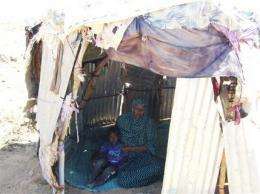Severe drought threatens millions in Somalia

(AP) -- A severe drought has plunged millions of Somalis into crisis after rains failed for several consecutive seasons in this Horn of Africa nation, and the U.N. and aid groups are warning of the possibility of a looming catastrophe.
The drought has increased the number of malnourished children in some regions, displaced thousands of people and killed thousands of animals. Officials in a central Somali region said 18 people died of drought-related effects.
"The situation is dire. It is an added vulnerability to an already extremely vulnerable people," the U.N.'s humanitarian chief, Valerie Amos, told The Associated Press after touring camps for displaced people in Somalia's semiautonomous region of Puntland on Wednesday.
Amos's one-day trip was intended, she said, "to remind the people that there is still a long, ongoing problem in Somalia. I don't want the people to forget Somalia. When you have an ongoing problem anywhere in the world, it is easy to slip it from the agenda."
The drought is the latest in a long line of problems for Somalia, which has been mired in conflict since 1991, when warlords toppled the country's last central government and then turned on each other.
According to the U.N., the malnutrition rate among children has jumped to 30 percent in Somalia's southern Juba region, a figure that is double the emergency threshold. Food prices have soared up to 80 percent in some regions.
The price increase in the south is attributable in part to traders who are hoarding the food to profit off the drought, said Grainne Moloney, the head of the U.N.'s food security and nutrition analysis unit in Nairobi, Kenya.
Many drought-affected families are fleeing their homes in search of food. In the Galmudug region of central Somalia, officials said they haven't seen such drought conditions since 1974.
Citing a recent survey conducted by his administration, Omar Mohamoud, a local government official, said the drought has killed 18 people and displaced thousands.
Mohamoud said his community has seen about 70 percent of its sheep and goats, 50 percent of its cattle and 30 percent of its camels die in the last three years.
"We are appealing to the international community to respond to the crisis and provide the people with water, food, medicine and shelter," said Mohamoud. "If the international community does not respond to the crisis urgently, a catastrophe of huge proportions is staring us right in the eyes."
The British aid group Oxfam says Somalia's current drought could be as serious as one in early 1990, when thousands of people died.
"The situation is bad now, but with more months of no rainfall it could become an absolute catastrophe," said Alun McDonald, the group's spokesman in Nairobi. He noted that weather predictions suggest that the next rains "will also be poor or even fail."
The poor rains are even affecting marriages. In a makeshift camp in Garowe town, Nura Farah, a mother of seven children, told AP that the lack of rains led to a divorce from her husband.
"When the drought hit us we quarreled," Farah said. "I told my husband, 'Look, you are a man. So go to town and look for ways to support your family.' But he rejected my request and divorced me and left."
Farah said she quit the nomadic life after her family's one male camel and 200 sheep and goats died in a month. Poverty has forced her and her children to seek shelter in relatives' homes in Garowe, the capital city of Puntland. Her 15-year-old son contracted tuberculosis because of a lack of food, she said.
The U.N. has released $4.5 million from its emergency fund to respond to the drought and is likely to release more in coming weeks, said Mark Bowden, U.N.'s Somalia humanitarian coordinator. This figure is separate from the $530 million the U.N. appealed for this year to finance its aid projects in Somalia.
The drought's effects are worsened by the fact aid agencies' work is restricted in many regions where Islamist insurgents are in control.
Peter Smerdon, the spokesman for the World Food Program, called on all parties to the Somali conflict to allow his agency free access to help the needy population. He said WFP has had to feed more than 130,000 additional people in Somalia because of the drought. Of Somalia's estimated population of around 8 million people, about 2.4 million need food aid and about 1.5 million are internally displaced.
Amos urged Somali politicians to inject "a sense of urgency to their discussions" to end decades of warfare.
Kiki Gbeho, the head of the U.N.'s office for the coordination of humanitarian affairs in Somalia, warned that if spring rains expected in April fail, the country "is in a huge problem."
©2010 The Associated Press. All rights reserved. This material may not be published, broadcast, rewritten or redistributed.


















